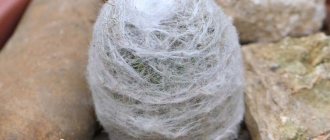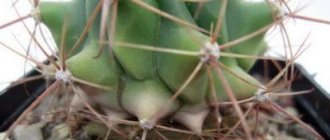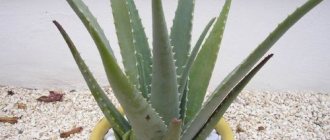Caring for cacti at home
After purchasing a cactus, it is important to provide it with optimal conditions for growth and development. They can be very different between desert and tropical varieties, but are fairly similar in most succulents.
Temperature
Optimal air temperature for cacti: +25...35 °C in summer and +5...10 °C in winter. Most species tolerate extremes of heat and cold well. Temperature disturbances slow down growth, but rarely lead to problems or death of succulents.
Lighting and location
Desert cacti need plenty of sunlight. They need to be kept in well-lit places, preferably on south, south-east or south-west windows. But forest varieties dry quickly in such conditions, so they should be placed in the shade on a northern, western or eastern window sill.
It is not advisable to move or rotate cacti.
If it becomes necessary to move a plant, make a mark on the pot so that in the new place it stands with the same side to the sun as in the old one.
Watering
The humidification mode must be selected depending on the type of cactus. Desert succulents can go without water for months, while tropical ornamental varieties require deep weekly watering. Plants quickly rot if there is excess liquid, so after each procedure it is necessary to wait until the soil is completely dry.
For irrigation, it is best to use filtered rainwater. Liquid from wells and springs is not suitable because it is too hard.
Chlorinated tap water must be settled and filtered through peat or activated carbon. To soften it, you can use a solution of oxalic or acetic acid (dilute 5 ml in 1 liter).
In spring and autumn, it is advisable to water succulents in the morning, and in the hot summer months - in the evening. This will allow the moisture to be absorbed into the roots of the plant without drying out. If the cacti are in a dusty room, they need to be additionally sprayed with a spray bottle.
To prevent stagnation of moisture in the soil, you need to regularly clean the drainage holes of the pots.
Fertilizer
Cacti do not need fertilizer. Plants do not tolerate most fertilizers well, so they are used only to save weakened or sick specimens, as well as in case of a long (more than 5 years) absence of flowering.
Rules for choosing a mixture:
- a minimum amount of organic components (they have a bad effect on the health of succulents);
- absence of nitrogen, which causes rotting and death of cacti;
- mineral component (calcium, phosphorus, magnesium in small quantities).
1 plant requires 5-10 g of fertilizer, depending on its size. The mixture can be used no more than once every 2 months.
What determines the growth rate?
The growth rate of a cactus primarily depends on its type.
You cannot demand a rapid increase in size from a plant that grows up to 1 centimeter as an adult. Slow growth of a prickly pet can be caused by:
- inappropriate lighting - if cactus babies do not like direct sunlight, then adult specimens, on the contrary, prefer bright light;
- incorrectly selected soil - too nutritious soil contributes to rotting of the root system and slower development;
- excessive watering;
- improper feeding;
- inappropriate pot sizes;
- the presence of diseases or pests.
If the cactus, instead of the usual thickening of the stem, begins to stretch upward, then this indicates an excess of nitrogen in the soil.
Compliance with all rules of propagation, selection of containers, soil, watering and feeding of cacti will contribute to a significant continuation of their life cycle.
How to replant a cactus
You need to replant succulents when they become cramped in an old pot. For young plants, it is advisable to carry out the procedure annually, for old plants – every 3-4 years. Timely and correctly carried out replanting has a beneficial effect on the health of the plant by renewing the soil and expanding the space.
Pot
The container for replanting should be 2-3 cm larger than the one in which the cactus grew before. There should be enough space for the plant's root system, but not too much: empty space is bad for succulents. It is optimal that the container size is 50% larger than the diameter of the roots, and the depth is 20% greater than their length.
You can choose pots of any shape and color, but they must have drainage holes at the bottom: otherwise moisture will begin to accumulate in the container, which will cause the plant to rot.
Young cacti prefer plastic containers that prevent soil leaching. Mature plants grow best in ceramic and clay pots.
Earth
You need to fill the pot for transplanting as follows:
- Fill the bottom with drainage mixture to 1-2 cm.
- Place some substrate on top.
- Leave the remaining layer underground. It should fill the pot without reaching 1 cm to the edge.
For optimal growth, desert cacti require loose, slightly to moderately acidic (pH 4.5 to 6.0), porous soil with good water permeability. The optimal composition of the soil mixture: leaf and turf soil, charcoal, washed river sand.
For succulents with white needles, add a little gypsum. Peat should be used carefully when growing cacti: it promotes plant growth, but slows down the processes of reproduction and flowering.
The choice of soil mixture depends on the plant variety. Unpretentious varieties, such as Echinopsis, grow well on a mixture of any soil and sand in a 1:1 ratio. Tropical cacti prefer clay substrate.
How to transplant
It is advisable to replant in the spring, when succulents begin their active growth stage. 2-3 days before the procedure, stop watering the plant so that the soil dries out and begins to fall freely from the roots. It is advisable to disinfect a new pot for a cactus by pouring boiling water over the inner and outer parts: this will protect it from diseases and parasites.
If the cactus is prickly, replanting is carried out wearing thick fabric gloves, and the plant itself is wrapped in several layers of newspaper, polystyrene foam or foam rubber.
Stages of work:
- Take the pot and turn it over. Using a thin stick or pencil, lightly press the soil inside the pot through the drainage holes so that the earth ball falls out.
- Shake off the root system from the remaining soil. If the plant is transplanted into a new soil mixture, it should be completely washed and cleaned.
- Trim overgrown roots. Treat the cut areas with charcoal.
- Place the plants in the pot, being careful not to wrap or bend the roots. Cover with substrate, but do not cover the bottom of the stem.
After replanting, it is recommended to compact the soil - sprinkle with pebbles or small crushed stone.
How to care after transplant
After transplantation, the cactus is placed in a quiet, shaded place. Humidification is stopped for 4-5 days, then watering is gradually resumed, starting with 20-50 ml of water per day. If necessary, it is alternated with liquid mineral fertilizers.
What cacti are suitable for the home?
For the first experiments, it is better to select cacti that are unpretentious in maintenance and adapted to the conditions of the apartment.
Desert cacti have a beautiful appearance and do not require special care: Acanthocalycium, Echinofossulocactus, Gymnocalycium, Mammillaria, Neolloydia, Notocactus, Parody, Telocactus and some others.
Tropical cacti that are easy to grow - Disocactus, Hylocereus, Hathiora, Schlumbergera, Rhipsalis, Lepismium, Epiphyllum. The Pereskia leaf cactus also grows well indoors.
IN THE PHOTO: Pereskia - leaf cactus
It is better to purchase cacti in specialized stores or from collectors, where the plant was kept in the necessary conditions. You need to buy apparently healthy specimens. Alarming signs that may indicate the presence of infectious diseases or the presence of pests are red stains, dark spots, changes in the color of the stem, and its wrinkling. After purchase, even a seemingly healthy cactus should be kept away from other plants for some time.
Caring for cacti during flowering
During the flowering period, succulents do not require complex care. Watering varieties such as epiphytes and prickly pears continues in the standard mode. Desert heat-tolerant cacti, such as cereus, are moistened with a sprinkler. If there is an excess of moisture, the flowers quickly begin to fall off, so you need to carefully control the amount of incoming water.
It is not advisable to feed and plant succulents during the flowering period.
What to do if the cactus does not bloom
The reason for the long absence of buds is most often a violation of the temperature regime. Before flowering, the cactus must spend the winter away from heat and sun. At this time, restructuring begins in its tissues, preparing the plant for growth and reproduction. If you do not provide it with such “hibernation”, the necessary processes will not start and flowers will not appear, therefore it is important to follow the rules of wintering.
Sick, weakened succulents also bloom poorly. The problem can be solved if you promptly treat them with medicinal products and feed them with fertilizers. But you should not apply such measures to healthy plants: this can lead to excessive growth, stem deformations and other inconveniences.
In many cactus varieties, buds appear only after reaching the desired age or size. Some varieties have a ripening period of more than several years, which is also worth considering if they do not bloom.
How to make it bloom
The key condition that stimulates the formation of flower buds is the duration of lighting. But not all species need increased daylight hours. For example, hatiore and mammillaria are abbreviated. This stimulates the manifestation of the survival instinct: flowering - for the implementation of reproductive functions.
Additionally, extreme conditions are created for cacti: watering is reduced and fertilizing is stopped. After laying flower buds, it is important not to change the position of the cactus. Rearranging or simply rotating the pot can cause the buds to drop.
Cacti are undemanding plants. They grow well without regular care and are suitable for landscaping country houses, offices and travelers' apartments.
Sources:
Gunther Anderson “Cacti in our house”, Arlen Burenkov “Cacti visiting and at home”;
Wintering a cactus
In winter, succulents need coolness (optimal temperature is 5-12 °C) and rest. During this period, the plant stops growing and prepares for future expenditure of energy on flowering and reproduction. The dormant period lasts 2-3 months, after which spring growth begins.
Rules for preparing for wintering:
- Before the rest period, it is necessary to reduce watering of the plant. They begin to do this in the fall, reducing the amount of water as the temperature and light intensity naturally decrease.
- When the plants are on the windowsill, they need to be protected from the heat of the radiators using plexiglass or other heat-insulating material. If this is not possible, the pots will have to be moved to a more suitable location.
- Do not let the temperature drop too much. Cacti do not tolerate frosts and drafts well, so if necessary, it is worth insulating the window frame with a layer of thick fabric or polystyrene foam.
A hibernating cactus should not show any signs of growth, including tilting towards the light. If the plant breaks dormancy, you need to return it to a room with a high temperature and resume watering, otherwise it will dry out and shrivel.
The oldest centenarian in the world
The record holder among long-lived cacti is Dendrocereus holoflora . This tree-like plant is found only in Cuba. The age of the oldest specimen, according to experts, is more than 500 years. It is located in the park of Varadero on the Hicacos Peninsula.
We have prepared interesting materials about cactus diseases and pests, types, reproduction, care, flowering, juice and fruits, spines, trichocereus and aporocactus.
Cactus propagation
Growing succulents in houses or apartments is quite easy. To do this, they use 3 main methods, each of which is worth considering in more detail.
From seeds
This type of reproduction is not in demand, as it takes a lot of time. Most often it is used by professional flower growers to grow rare species and develop new varieties. The seeds are soaked in a solution of potassium permanganate for 1 day and evenly laid out in a pot on leveled soil, then moistened, covered with glass and placed in a permanent place.
The optimal temperature for growing is 25-40 °C. The soil with seeds must be constantly kept moist by spraying it with a spray bottle. After germination, the glass is removed and the pot is transferred to the sun.
Cuttings
This type of propagation is used in species with long, not too thick stems. The top of the cactus (at least 2 cm) is cut off with a sharp knife, previously disinfected with alcohol. The cuttings are placed on paper and left to dry in a dark, cool place for 3-4 days.
When it dries, prepare a pot: drainage is placed in it and soil is filled, and 2-3 small flat stones are placed on top. The future cactus is placed on them, cut side down, making sure that it does not touch the substrate. The container is placed in a place with dim, diffused light.
After 1-2 weeks, roots appear on the cuttings. When this happens, the stones are removed and it is replanted in the soil.
Children
The easiest way to propagate cacti is vegetatively. With a sufficient amount of nutrients, a mature plant will begin to form shoots (“babies”) from the areoles.
They are already formed succulents with their own tissues and systems, spines and skin. They can be separated from the main plant when their roots become visually visible.
The formation of shoots begins after the root system of the main cactus completely occupies the pot. Therefore, when propagating succulents in this way, you should not rush to replant.
They are often grown as house plants.
2. In total, there are about 3 thousand species of cacti in the world.
3. Their first species appeared on Earth, according to various estimates, 30-35 million years ago.
4. The modern name “cactus” for this type of plant was invented by Carl Linnaeus. It comes from the ancient Greek word "kaktos", which was the designation of any plant with thorns.
5. Cacti are perennial plants, some species live for hundreds of years.
6. Before the discovery of the New World by Columbus, Vespucci and other navigators, cacti were unknown to Europeans.
GIANT CACTUS
7. There are many types of this plant. Some of them grow up to 20 meters in height (giant cereus), while others barely reach a few centimeters.
8. Pollination of cacti is carried out by bees, butterflies, hummingbirds and even bats.
9. Cacti are touch-me-nots. Although this plant is unpretentious, it does not like unnecessary attention. Excessive manipulation can lead to death.
10. Cacti have adapted to life in the desert; they can easily tolerate heat up to +60 degrees.
11. Thanks to their beauty and unpretentiousness, many cacti quickly became quite popular as indoor plants, although, of course, home specimens are difficult to compare with the majestic giants growing in the wild.
12. House cacti do not often need to be turned on the other side to the sunlight. This can lead to weakening of the plant and even loss of needles.
13. In some countries, entire cactus plantations are grown to produce red dye.
14. The stems of cacti store water reserves, which, as a rule, are safe for humans (be careful, there are poisonous cacti).
15. In Mexico, a dessert made from slices of cactus in sugar is very popular.
16. These desert plants have become a symbol of the state of Arizona.
17. A series of experiments have shown that dry-loving plants contain antibiotics, killing 85 percent of organisms that might attack the plant.
18. Many people are of the opinion that the desert plant absorbs radiation. In fact, this is not true. This myth stems from an interesting fact about the plant: it grows better in areas where the level of electromagnetic radiation is increased (coincidentally).
19. Once upon a time, prickly pear cacti almost caused an environmental disaster in Australia. Prickly pears brought to this continent rapidly captured more and more new spaces, displacing other plants and, with their thorns, killing the cattle that ate them. The Argentine moth, introduced for this purpose, helped cope with the cactus invasion. They even erected a monument to her in Australia.
20. Columbus was the first to see that thorny plants were eaten. He saw the Aborigines eating “prickly melons,” which soon became known as cacti.
21. The smallest cactus in the world is Blossfeldia. Its height ranges from 1 to 3 centimeters.
22. Lophophora Williams is revered as a divine plant by many Indian tribes in Latin America. The Indians are sure that when you meet this cactus you must say hello, otherwise the plant will be offended and send damage to the impolite person.
CACTi IN MEXICO
23. The natives of South America have long used cactus needles for surgical purposes, using them to stitch wounds.
24. Many peoples associate the New Year with an elegant, beautiful Christmas tree, but not among Mexicans, because in Mexico they decorate large cacti instead of a Christmas tree.
25. The largest cactus reached a height of almost 25 meters. In 1978, it ceased to exist due to the raging elements.
26. Donkeys in South America know how to knock thorns off cacti with their hooves, so that they can then calmly eat them. European animals do not have such skills.
27. Cactus stems are used to make traditional Argentine drums.
28. In Paraguay, baked green spines are considered a real delicacy.
29. Cacti have nothing to do with tequila. Many people mistakenly assume that tequila is made from the sap of a thorny plant, but this is misleading. Tequila is made from agave.
30. People who believe that cacti cannot be replanted are by no means right. Plants require replanting once a year. This stimulates root growth and promotes flowering.
CACTUS GARDEN IN MONTE CARLO
31. In Monte Carlo, on the shores of the Mediterranean Sea, a whole garden of cacti of different types and sizes was planted.
32. Green spines of cacti contain many vitamins and other useful substances. Therefore, cacti are used both in medicine and in cosmetology. For example, soap and shampoos are made from them.
33. Scientists have proven that cactus spines ionize the air.
34. Dogs and wolves are very afraid of cacti, even if they see them for the first time.
35. In Mexico, cacti are food for cows because many farmers are convinced that green plants increase milk production.
FLOWERING CACTI
36. Many people believe that cacti bloom only once in a lifetime, but this is not true. The plant blooms every year.
37. The roots of cacti, unlike the roots of trees, go only slightly into the ground, which is why they are easy to uproot or knock down. But they grow significantly in width so that in case of rain they absorb moisture from the maximum available area.
38. Some types of cacti contain an intoxicating substance - mescaline. When consumed, a person experiences hallucinations.
39. Previously, mescaline, contained in desert plants, was used by shamans to plunge into a trance.
40.You can get a prison sentence for importing certain types of cacti into Russia.
41. Near the village of Novy Svet in Crimea there is a field where cacti grow wild.
42. Europe's first collection of cacti appeared in the 16th century in London, collected by an inquisitive local pharmacist.
43. From 75 to 90 percent of the mass of a cactus is water. The exact value depends on the type of plant and its current moisture supply.
44. The tallest cactus ever found grew to 24 meters and is estimated to be 150 years old. It is still growing, being under official state protection. For his damage, the authorities promise 25 years in prison.
45. In 1956, one Brazilian resident found himself with 267 cactus needles in 15 seconds. No one has yet managed to surpass this dubious record.
46. Thorns replace leaves for cacti, but much less moisture evaporates from them than from flat leaves. Their other function is to protect the plant from animals.
47. Mexican farmers actively feed their cows prickly pear cacti, which contain a lot of water, as this allows them to increase milk production. Cows like this food, but it has to be cleared of thorns before feeding the animals, otherwise they may get hurt.
48. In some Latin American countries, homeowners plant rows of spiny cacti along their fences for added protection. It is extremely difficult to overcome such a wall.
49. In Paraguay and Bolivia, cacti of the species Neowerdermannia/Weingartia are on the verge of extinction.
50. Cacti play an important role in the ecosystem of the regions where they grow.
photo from open sources
Cactus pruning
Cutting off excess parts of plants prolongs their life, stimulates growth, and promotes abundant flowering. Cacti are no exception: timely pruning will have a positive effect on the health of many varieties.
Is it possible to trim
Pruning cacti is legal and beneficial.
It must be done in the following cases:
- the appearance of rot;
- severe distortion, deformation of the stem;
- excessive growth.
Some ornamental varieties require regular pruning for normal functioning.
Rules
To prevent pruning from causing harm to the plant, you must adhere to the following rules:
- use only a disinfected knife;
- treat large and small cuts with crushed coal;
- After the procedure, place the cactus in the shade so that the wound can dry out:
- do not allow the cut to come into contact with the ground.
After pruning, you need to monitor the plant in order to notice signs of weakening or infections in time and take action.
Briefly about the main thing
Cacti are plants that have adapted to harsh living conditions in deserts. In the process of evolution, the leaves of succulents turned into spines or hairs, and the stems became thicker and learned to accumulate moisture in reserve. Many types of cacti can be successfully grown at home. They decorate the interior of the house with their exotic appearance and beautiful fragrant flowers.
The wide variety of succulent species gives you plenty of choice. There are cacti with and without needles, with different stem shapes - round, columnar, cylindrical, branched. But in order to achieve a beautiful appearance and abundant flowering, it is necessary to provide the plant with the necessary conditions.
Diseases and pests of cacti
Cacti, despite their unpretentiousness, are susceptible to various diseases. It is easier to save a plant from them in the early stages of infection, so gardeners should familiarize themselves with the common pathologies of succulents.
The plant turns yellow
Yellowing of plants is most often caused by a lack of nutrients in the soil. Fertilizing, adding fertilizers, and replanting in enriched soil will help solve the problem. Less commonly, the yellow color of a cactus is a symptom of infection with the jaundice virus. This disease is incurable and leads to the death of affected specimens.
Rotting
Rot on cacti is most often a consequence of excessive watering and high humidity.
It can be a symptom of diseases such as:
- cactus late blight;
- helminthosporiosis;
- rhizoctoniasis;
- fusarium;
- black rot;
- anthrocnosis.
Rotting is most often caused by fungi, less often by bacteria. The treatment regimen is selected depending on the degree of damage and the specifics of the disease.
Doesn't grow
The lack of visible growth in cacti can be a sign of a variety of diseases and parasites: you need to focus on the accompanying symptoms. If there are no other signs of trouble, then the cause of slow development is errors in care: watering with cold water, lack of light, improper transplanting and rearrangement.
In addition, succulents naturally slow down their growth during the winter and after flowering.
Pests
Cacti are susceptible to infection by the following types of parasites:
- spider mites;
- root nematodes;
- aphids (leaf varieties);
- scale insects and false scale insects;
- mealybugs;
- felters.
Symptoms of pest infestation include drying out of the plant, slower development, and the appearance of white films and discharge on the surface. Sometimes you can see insects crawling on the surface of the cactus.
Useful tips
- A little about the daily routine. From October to March, on average, the plant should sleep. At this time, you should provide him with cold, hunger and peace - on average + 5-15 ° C and a complete lack of watering. There is no need to feel sorry for the “poor, unfortunate, shriveled plant”: many succulents dry out to such a state that they hide in stones. There is no need to be afraid - they will warm themselves up in the spring. How to achieve such temperatures in an apartment? It depends on the window sill: in some places it’s enough to move it close to the glass, in others you’ll have to fence it off from the radiator (for example, with simple cling film on a wire frame) or put the cacti in a tall aquarium - it’s more beautiful. In winter, the plants will rest, gain strength, lay flower buds and in the warm season will delight you with fantastic flowering!
- Watering in the spring is resumed carefully: the plant should not wake up at a time when there is still little sun and water is already flowing, otherwise it will begin to “stretch” in search of light, losing its shape.
- In the warm season, cacti are watered as the soil dries out, and it is more dangerous to overwater than to dry out. In this regard, cacti are very convenient plants for vacationers: they will perfectly wait for you for 2-4 weeks without water.











